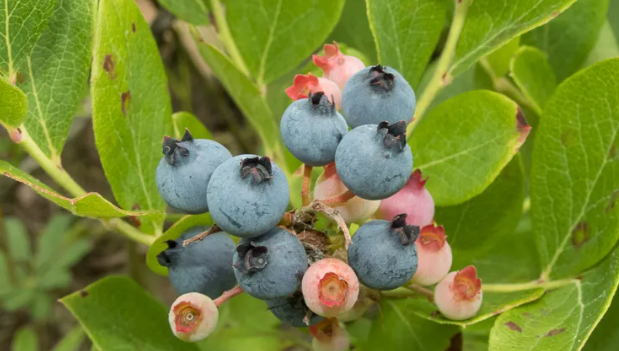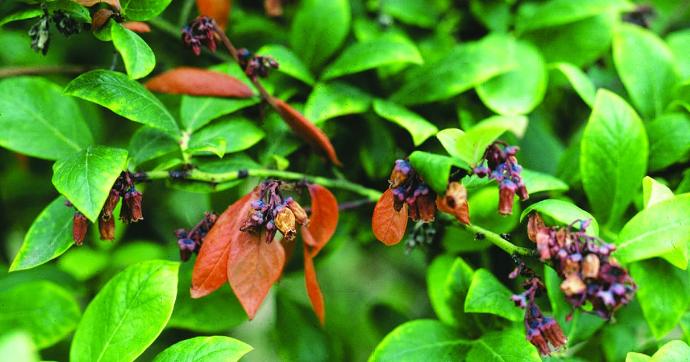Hillside Blueberry
Hillside blueberry shrubs, 2-3 feet tall in Zones 4-8, grow slowly in well-drained, acidic soil under full sun to partial shade. Known for their small and flavorful berries, hillside blueberries are a delightful addition to gardens.

Habit
Shrub
Height
0.5-1.5 m
Growth
Slow
Soil
Acidic, well-drained soil
Shade
Full Sun to partial shade
Moisture
Moist
Edible
Yes
Medicinal
Yes
Origin
North America
Climatic Condition
Temperate
Temperature (°)
10-25°C
Humidity (%)
60-80%
Potting media
Peat-based mix
Fertilizers
Organic fertilizer
Watering
Needs regular watering, prefers moist, acidic soil
Plant Weight
0.2-0.5 kg
Flowering Time
Summer
Soil Ph level
4.5 - 5.5
Water Ph level
4.5 - 5.5
Soil EC
0.8 dS/m
Yield Per Plant
3-5 kg fruit
NPK ratio
10:10:10
life Span
Perennial
Health Benefits
Rich in antioxidants, supports digestive health.
Suggested Grow Media or Potting Mix ?
50% peat, 25% compost, 25% sand
Suggested Fertigation/Fertilizers
Fertilize every 2-3 weeks with an acid fertilizer.
Common Diseases and Remedies
Root rot , Blueberry scorch virus .
Reddish-brown discolouration of roots , Stunted growth .
Pruning , Sanitation Spray Azadirectin .
HEALTH BENEFITS
· High in antioxidants, beneficial for brain health and reducing inflammation.
· Supports heart health and may help regulate blood sugar.
What Is An Hillside Blueberry?
Hillside blueberry (Vaccinium pallidum) is a blueberry tree that grows in central and eastern North America. It is also called Blue Ridge blueberry, late lowbush blueberry, and early lowbush blueberry.

What Are The Different Types Of Hillside Blueberry?
1. Vaccinium angustifoliu
Blueberry tree that grows in heavy soil and produces antioxidants and phenolic compounds.
Small blueberry that grows in the right conditions and looks like a low bush blueberry.
3. Vaccinium corymbosum
Also known as highbush blueberry, this plant is an upright plant that grows in forests, swamps, swamps and plains.
4. Rabbiteye
Hardy tree with firm and firm fruits that can tolerate many climates.

How To Care For Hillside Blueberry?
Blueberry likes deep and sparse water. You'll need to soak them in a gallon of water at a time, especially if they're planted in pots. Pots hold less water and the soil dries faster. Water every 3 to 5 days in a cool place.
1. Location
Under the tree or east of the building.
2. Sunlight
Hillside blueberry (Vaccinium pallidum) needs 3-6 hours of direct sunlight per day to thrive.
3. Soil
Strongly acidic, fertile, aerated, moist and well drained. The ideal soil pH for good growth is 4.0 to 5.5
4. Hydration
Hillside blueberries prefer deep, low water .

5. Nutrition :
One cup of blueberries provides 25% and approximately 8% of the recommended daily intake of vitamin C . It also contains: Protein: 1 G. Fat: Less than 1 g .
6. Issues :
The leaves of overwatered hillside blueberries will begin to turn yellow, drop, and wilt. The plant may also appear dull and unhealthy, with signs of soft stems.
What Are The Benefits Of Hillside Blueberry?
High antioxidant levels. Blueberries are one of the best natural sources of antioxidants.
1. Low cholesterol.
2. High blood pressure.
3. Glycemic control.
4. Better digestion.
FAQs About Growing Hillside Blueberries?
1. Also called blueberries?
Huckleberry (bog blueberry/blueberry, northern blueberry, or western blueberry)
2. What type of berry is a blueberry?
For example, raspberries, blackberries, and strawberries are not true berries; They are all fruits consisting of many small fruits. But cranberries and blueberries are real plants.
3. Where do blueberries come from?
Answers Oregon, Washington, Georgia, Michigan, California, New Jersey, North Carolina, Florida, Texas and Minnesota.
4. How to identify blueberries?
Calyx remaining at the tip of the flower, with small, rounded or flat, blue to blue-black when aged, usually waxy flowers.




